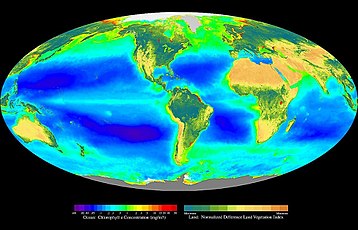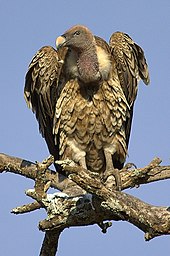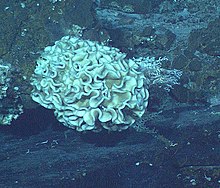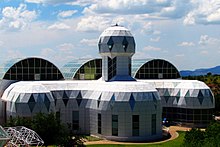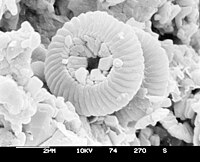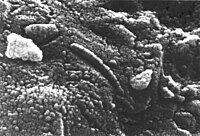Knowledge is a familiarity, awareness, or understanding of someone or something, such as facts, information, descriptions, or skills, which is acquired through experience or education by perceiving, discovering, or learning.
Knowledge can refer to a theoretical or practical understanding of a subject. It can be implicit (as with practical skill or expertise) or explicit (as with the theoretical understanding of a subject); it can be more or less formal or systematic. In philosophy, the study of knowledge is called epistemology; the philosopher Plato famously defined knowledge as "justified true belief", though this definition is now thought by some analytic philosophers to be problematic because of the Gettier problems while others defend the platonic definition. However, several definitions of knowledge and theories to explain it exist.
Knowledge acquisition involves complex cognitive processes: perception, communication, and reasoning; while knowledge is also said to be related to the capacity of acknowledgement in human beings.
Theories of knowledge
Robert Reid, Knowledge (1896). Thomas Jefferson Building, Washington, D.C.
The eventual demarcation of philosophy from science was made possible by the notion that philosophy's core was "theory of knowledge," a theory distinct from the sciences because it was their foundation... Without this idea of a "theory of knowledge," it is hard to imagine what "philosophy" could have been in the age of modern science.The definition of knowledge is a matter of ongoing debate among philosophers in the field of epistemology. The classical definition, described but not ultimately endorsed by Plato, specifies that a statement must meet three criteria in order to be considered knowledge: it must be justified, true, and believed. Some claim that these conditions are not sufficient, as Gettier case examples allegedly demonstrate. There are a number of alternatives proposed, including Robert Nozick's arguments for a requirement that knowledge 'tracks the truth' and Simon Blackburn's additional requirement that we do not want to say that those who meet any of these conditions 'through a defect, flaw, or failure' have knowledge. Richard Kirkham suggests that our definition of knowledge requires that the evidence for the belief necessitates its truth.
In contrast to this approach, Ludwig Wittgenstein observed, following Moore's paradox, that one can say "He believes it, but it isn't so," but not "He knows it, but it isn't so." He goes on to argue that these do not correspond to distinct mental states, but rather to distinct ways of talking about conviction. What is different here is not the mental state of the speaker, but the activity in which they are engaged. For example, on this account, to know that the kettle is boiling is not to be in a particular state of mind, but to perform a particular task with the statement that the kettle is boiling. Wittgenstein sought to bypass the difficulty of definition by looking to the way "knowledge" is used in natural languages. He saw knowledge as a case of a family resemblance. Following this idea, "knowledge" has been reconstructed as a cluster concept that points out relevant features but that is not adequately captured by any definition.
Communicating knowledge
Los portadores de la antorcha (The Torch-Bearers) – Sculpture by Anna Hyatt Huntington symbolizing the transmission of knowledge from one generation to the next (Ciudad Universitaria, Madrid, Spain)
Symbolic representations can be used to indicate meaning and can be thought of as a dynamic process. Hence the transfer of the symbolic representation can be viewed as one ascription process whereby knowledge can be transferred. Other forms of communication include observation and imitation, verbal exchange, and audio and video recordings. Philosophers of language and semioticians construct and analyze theories of knowledge transfer or communication.
While many would agree that one of the most universal and significant tools for the transfer of knowledge is writing and reading (of many kinds), argument over the usefulness of the written word exists nonetheless, with some scholars skeptical of its impact on societies. In his collection of essays Technopoly, Neil Postman demonstrates the argument against the use of writing through an excerpt from Plato's work Phaedrus (Postman, Neil (1992) Technopoly, Vintage, New York, pp 73). In this excerpt, the scholar Socrates recounts the story of Thamus, the Egyptian king and Theuth the inventor of the written word. In this story, Theuth presents his new invention "writing" to King Thamus, telling Thamus that his new invention "will improve both the wisdom and memory of the Egyptians" (Postman, Neil (1992) Technopoly, Vintage, New York, p. 74). King Thamus is skeptical of this new invention and rejects it as a tool of recollection rather than retained knowledge. He argues that the written word will infect the Egyptian people with fake knowledge as they will be able to attain facts and stories from an external source and will no longer be forced to mentally retain large quantities of knowledge themselves (Postman, Neil (1992) Technopoly, Vintage, New York, p. 74).
Classical early modern theories of knowledge, especially those advancing the influential empiricism of the philosopher John Locke, were based implicitly or explicitly on a model of the mind which likened ideas to words. This analogy between language and thought laid the foundation for a graphic conception of knowledge in which the mind was treated as a table, a container of content, that had to be stocked with facts reduced to letters, numbers or symbols. This created a situation in which the spatial alignment of words on the page carried great cognitive weight, so much so that educators paid very close attention to the visual structure of information on the page and in notebooks.
Major libraries today can have millions of books of knowledge (in addition to works of fiction). It is only recently that audio and video technology for recording knowledge have become available and the use of these still requires replay equipment and electricity. Verbal teaching and handing down of knowledge is limited to those who would have contact with the transmitter or someone who could interpret written work. Writing is still the most available and most universal of all forms of recording and transmitting knowledge. It stands unchallenged as mankind's primary technology of knowledge transfer down through the ages and to all cultures and languages of the world.
Situated knowledge
Situated knowledge is knowledge specific to a particular situation. It is a term coined by Donna Haraway as an extension of the feminist approaches of "successor science" suggested by Sandra Harding, one which "offers a more adequate, richer, better account of a world, in order to live in it well and in critical, reflexive relation to our own as well as others' practices of domination and the unequal parts of privilege and oppression that makes up all positions." This situation partially transforms science into a narrative, which Arturo Escobar explains as, "neither fictions nor supposed facts." This narrative of situation is historical textures woven of fact and fiction, and as Escobar explains further, "even the most neutral scientific domains are narratives in this sense," insisting that rather than a purpose dismissing science as a trivial matter of contingency, "it is to treat (this narrative) in the most serious way, without succumbing to its mystification as 'the truth' or to the ironic skepticism common to many critiques."Haraway's argument stems from the limitations of the human perception, as well as the overemphasis of the sense of vision in science. According to Haraway, vision in science has been, "used to signify a leap out of the marked body and into a conquering gaze from nowhere." This is the "gaze that mythically inscribes all the marked bodies, that makes the unmarked category claim the power to see and not be seen, to represent while escaping representation." This causes a limitation of views in the position of science itself as a potential player in the creation of knowledge, resulting in a position of "modest witness". This is what Haraway terms a "god trick", or the aforementioned representation while escaping representation. In order to avoid this, "Haraway perpetuates a tradition of thought which emphasizes the importance of the subject in terms of both ethical and political accountability".
Some methods of generating knowledge, such as trial and error, or learning from experience, tend to create highly situational knowledge. One of the main attributes of the scientific method is that the theories it generates are much less situational than knowledge gained by other methods. Situational knowledge is often embedded in language, culture, or traditions. This integration of situational knowledge is an allusion to the community, and its attempts at collecting subjective perspectives into an embodiment "of views from somewhere."
Knowledge generated through experience is called knowledge "a posteriori", meaning afterwards. The pure existence of a term like "a posteriori" means this also has a counterpart. In this case, that is knowledge "a priori", meaning before. The knowledge prior to any experience means that there are certain "assumptions" that one takes for granted. For example, if you are being told about a chair, it is clear to you that the chair is in space, that it is 3D. This knowledge is not knowledge that one can "forget", even someone suffering from amnesia experiences the world in 3D.
Even though Haraway's arguments are largely based on feminist studies, this idea of different worlds, as well as the skeptic stance of situated knowledge is present in the main arguments of post-structuralism. Fundamentally, both argue the contingency of knowledge on the presence of history; power, and geography, as well as the rejection of universal rules or laws or elementary structures; and the idea of power as an inherited trait of objectification.
Partial knowledge
The parable of Blind men and an elephant suggests that people tend to project their partial experiences as the whole truth
One discipline of epistemology focuses on partial knowledge. In most cases, it is not possible to understand an information domain exhaustively; our knowledge is always incomplete or partial. Most real problems have to be solved by taking advantage of a partial understanding of the problem context and problem data, unlike the typical math problems one might solve at school, where all data is given and one is given a complete understanding of formulas necessary to solve them.
This idea is also present in the concept of bounded rationality which assumes that in real life situations people often have a limited amount of information and make decisions accordingly.
Intuition is the ability to acquire partial knowledge without inference or the use of reason. An individual may "know" about a situation and be unable to explain the process that led to their knowledge.
Scientific knowledge
The development of the scientific method has made a significant contribution to how knowledge of the physical world and its phenomena is acquired. To be termed scientific, a method of inquiry must be based on gathering observable and measurable evidence subject to specific principles of reasoning and experimentation. The scientific method consists of the collection of data through observation and experimentation, and the formulation and testing of hypotheses. Science, and the nature of scientific knowledge have also become the subject of Philosophy. As science itself has developed, scientific knowledge now includes a broader usage in the soft sciences such as biology and the social sciences – discussed elsewhere as meta-epistemology, or genetic epistemology, and to some extent related to "theory of cognitive development". Note that "epistemology" is the study of knowledge and how it is acquired. Science is "the process used everyday to logically complete thoughts through inference of facts determined by calculated experiments." Sir Francis Bacon was critical in the historical development of the scientific method; his works established and popularized an inductive methodology for scientific inquiry. His famous aphorism, "knowledge is power", is found in the Meditations Sacrae (1597).
Until recent times, at least in the Western tradition, it was simply taken for granted that knowledge was something possessed only by humans – and probably adult humans at that. Sometimes the notion might stretch to Society-as-such, as in (e. g.) "the knowledge possessed by the Coptic culture" (as opposed to its individual members), but that was not assured either. Nor was it usual to consider unconscious knowledge in any systematic way until this approach was popularized by Freud.
Other biological domains where "knowledge" might be said to reside, include: (iii) the immune system, and (iv) in the DNA of the genetic code. See the list of four "epistemological domains": Popper, (1975); and Traill (2008: Table S, p. 31) – also references by both to Niels Jerne.
Such considerations seem to call for a separate definition of "knowledge" to cover the biological systems. For biologists, knowledge must be usefully available to the system, though that system need not be conscious. Thus the criteria seem to be:
- The system should apparently be dynamic and self-organizing (unlike a mere book on its own).
- The knowledge must constitute some sort of representation of "the outside world", or ways of dealing with it (directly or indirectly).
- Some way must exist for the system to access this information quickly enough for it to be useful.
Religious meaning of knowledge
In many expressions of Christianity, such as Catholicism and Anglicanism, knowledge is one of the seven gifts of the Holy Spirit.The Old Testament's tree of the knowledge of good and evil contained the knowledge that separated Man from God: "And the LORD God said, Behold, the man is become as one of us, to know good and evil..." (Genesis 3:22)
In Gnosticism, divine knowledge or gnosis is hoped to be attained.
विद्या दान (Vidya Daan) i.e. knowledge sharing is a major part of Daan, a tenet of all Dharmic Religions. Hindu Scriptures present two kinds of knowledge, Paroksh Gyan and Prataksh Gyan. Paroksh Gyan (also spelled Paroksha-Jnana) is secondhand knowledge: knowledge obtained from books, hearsay, etc. Prataksh Gyan (also spelled Prataksha-Jnana) is the knowledge borne of direct experience, i.e., knowledge that one discovers for oneself. Jnana yoga ("path of knowledge") is one of three main types of yoga expounded by Krishna in the Bhagavad Gita. (It is compared and contrasted with Bhakti Yoga and Karma yoga.)
In Islam, knowledge (Arabic: علم, ʿilm) is given great significance. "The Knowing" (al-ʿAlīm) is one of the 99 names reflecting distinct attributes of God. The Qur'an asserts that knowledge comes from God (2:239) and various hadith encourage the acquisition of knowledge. Muhammad is reported to have said "Seek knowledge from the cradle to the grave" and "Verily the men of knowledge are the inheritors of the prophets". Islamic scholars, theologians and jurists are often given the title alim, meaning "knowledgeble".
In Jewish tradition, knowledge (Hebrew: דעת da'ath) is considered one of the most valuable traits a person can acquire. Observant Jews recite three times a day in the Amidah "Favor us with knowledge, understanding and discretion that come from you. Exalted are you, Existent-One, the gracious giver of knowledge." The Tanakh states, "A wise man gains power, and a man of knowledge maintains power", and "knowledge is chosen above gold".
As a measure of religiosity in sociology of religion
According to the sociologist Mervin F. Verbit, knowledge may be understood as one of the key components of religiosity. Religious knowledge itself may be broken down into four dimensions:- content
- frequency
- intensity
- centrality




